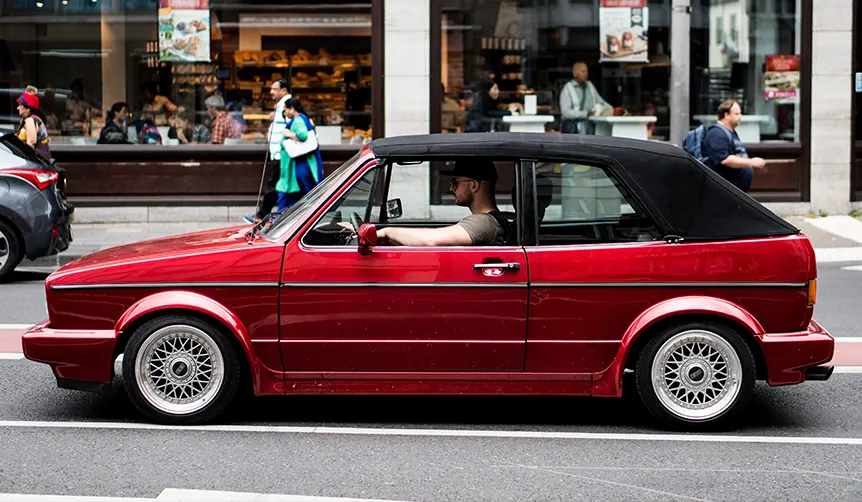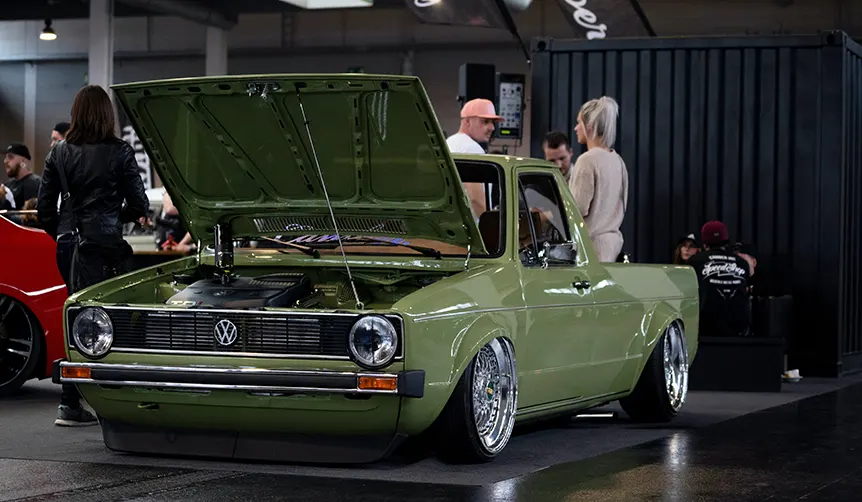About Volkswagen Mk1 Golfs
The first generation Golf, or Mk1 - Mark 1 - was released in 1974 and was to replace the aged VW Beetle. The Golf (the name had nothing to do with the sport but is the German spelling of Gulf, as in Gulf Stream) differed very much to the Beetle mechanically as well as aesthetically, moving from a rear-mounted air-cooled engine to a front mounted liquid-cooled engine using technology that came with purchasing Audi (that's why many Mk1 engine components have Audi logos stamped on them). However, the end goal was the same: to build a small, economical, and affordable family car.
Several variations of the base 2 and 4 door cars were made, as follows.
GTi - the first hot hatch
The Golf was never meant to be fast, let alone a sports car. As a kind of gimmick, engineers at the Volkswagen factory fitted a light little Golf with a Bosch mechanical fuel injection unit, usually reserved for sports and upmarket cars. The project caught the eye of a few higher-ups and a short production run was arranged. At first, VW execs were cautious of the idea and only intended to sell the quick GTi in Germany but demand from other countries, particularly the UK, influenced VW enough to take production seriously. Thus the concept of the 'hot hatch' was born.
GTis feature either a 1.6 or 1.8lt mechanical injected SOHC engine and are distinguished by a red trim line around the grill, tartan seats, and commonly additional gauges in the centre console. GTi stands for Grand Touring Injected.
Cabriolet
The Cabriolet is simply the convertible version of the Golf (sometimes these weren't called Golfs at all - just VW Cabriolet). These cars were actually not built by VW, but were built by the independent car factory Karmann (known for the Karmann Ghia, which actually uses many components from the Beetle). As a result, the Karmann factory kept making Mk1 Cabriolets well passed when Volkswagen themselves ceased production. That's why it's possible to buy car made in 1993 closely resembling the same model first made in 1974. Late model Cabriolets were fitted with modern body kits, the more contemporary 1.8lt injected engine and different, newer interiors in an effort to give the aging car a more modern appearance.
All Cabriolets came from the Karmann factory, and all Cabriolets built during the Mk2 Golf run are still Mk1s, though are colloquially called Mk1.5s.
Due to it's long life span, there were many, many different special edition Cabriolets. You can read more about the different models here on Cabby Info's excellent site.

Photo by Conor Samuel on Unsplash
"Mk1.5"
"Mk1.5" is a colloquial term for the Karmann factory built Cabriolet. When its production run coincided with the VW built Mk2 Golf hatchback Karmann added some Mk2 components, like the alloy wheels.
"Clipper"
Refers to the generation of Mk1 Cabriolets that received the plastic colour-matched "Clipper" body kit introduced in 1988, replacing the chrome bumpers. The cars often also utilised the larger 1.8lt injected engine.
Diesel
Diesel Mk1s were first manufactured in 1976. Performance wise, these cars were very comparable to smaller petrol engine Mk1s. Many engine components are shared between both diesel and petrol models.
GTD
The GTD was the sporty version of the diesel Golf and incorporated the GTi's suspension. Extra power came from a Garret turbo, providing very competitive performance.
Rabbit and Caribe
The Volkswagen Rabbit and Caribe were the local names given to the Golf in the USA and Mexico, respectfully. They are essentially the same car as their European counterparts, though some later models had square headlights. The Rabbit name was later dropped.
"Swallowtail"
Refers to early versions of the hatchback that have a slightly different design in the rear hatch between the taillights.
Citi Golf
Citi Golfs were made in South Africa between 1984 and 2009. They are still, fundamentally, Mk1 Golfs but with some subtle changes, including a slightly sloping front grill, different C pillar design, and integrated rear window wiper. The most significant change was the addition of a new Skoda dashboard in 2004.
Caddy
Caddys are not technically Golfs. They're the pickup or ute version of the Mk1 hatchback (golf caddy - get it?). They are still considered Mk1s though and share many, many parts being almost incidental except for the body work. The Caddy name still lives on in the modern Golf-based small van.

Photo by Tim Meyer on Unsplash
Scirocco
Before the GTi there was the sporty Scirocco coupe. In fact before the Golf, there was the Scirocco. VW used the sportscar to sort out any issues with the shared drive train before the Gold went into mass-production.
The Scirocco is not really a Golf either, but they did share the engine, drivetrain and many other components.
Not members of the Mk1 family
- Mk1 Polo - Sure, it looks like an even smaller version of the Mk1 Golf, but the first generation Polo is actually a rebadged Audi 50 with a range of small capacity engines.
- Mk1 Gol - Though later models of the Brazilian Gol did receive a watercooled engine, the initial generation still retained the air-cooled engine from the Beetle.
- VW Cabrio - This was the name VW/Karmann gave the successor of the Mk1 Cabriolet, which was based on a Mk3 Golf.